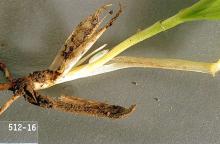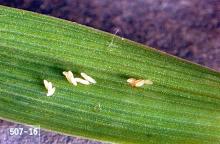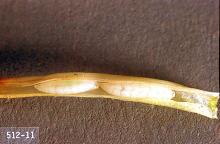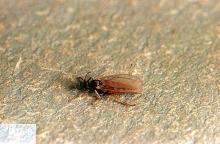Mayetiola destructor
Pest description and crop damage Adult is a delicate, mosquito-like fly with a reddish brown to dusky black body. Adults do not cause any feeding damage, but they lay their eggs on the leaves within 2 to 4 days of emergence. The eggs hatch within 10 days and the larvae (maggots) start moving down the stem just beneath leaf-sheaths. When at or near the crown of the plant, they use their mouthparts to rasp the tissue and feed on the sap through the wound. Larval feeding stunts plants and reduces yield. Infested wheat seedlings can be darker than the healthy non-infested plants. Hessian fly is a threat to both fall spring seeded crops. Greatest damage is usually to wheat, but barley and rye also are attacked. Oats are resistant to this pest. Insects overwinter in puparial "flaxseed" stage in stubble, volunteer wheat, and fields seeded before mid-October.
Management-cultural control
Planting resistant cultivars is the most effective approach to minimize losses to this pest. Consult your crop advisor, extension educator, or specialist to select recommended varieties for planting in your region.
Deep plowing soon after harvest is helpful if soil conditions permit this practice. Direct seeding in the drylands of Washington and Idaho, prevents deep plowing. Follow cultural practices that lead to optimum production. Winter wheat seeded after mid-October is usually free of this pest. Control volunteers to eliminate the green bridges, for this and other pests. Spring wheat seeded behind failed fall-seeded wheat is especially prone to attack.
Management-chemical control
Seed treatments
Seed treatments applied to wheat and barley seed may help control Hessian fly.
- clothianidin (NipsIt Inside) at 1.79 fl oz (0.07 lb ai)/100 lb seed on-farm application. REI 12 hr. Do not exceed 0.2 lb ai/A clothianidin per year.
- imidacloprid (Gaucho 600F) at 0.8 to 2.4 fl oz (0.031 to 0.094 lb ai) per 100 lb seed. Do not graze or feed livestock on treated areas within 45 days after planting. REI 12 hr.
- imidacloprid/metalaxyl/tebuconazole (GauchoXT) at 3.4 to 4.5 fl oz (0.031 to 0.041 lb ai) /100 lb seed; early season protection. Do not graze or feed livestock on treated areas within 45 days after planting. REI 24 hr. Groundwater advisory: metalaxyl is known to leach through soil into groundwater under certain conditions as a result of agricultural use. Wheat, oats.
- thiamethoxam (Cruiser 5FS) at 0.75 to 1.33 fl oz (0.029 to 0.052 lb ai) per 100 lb seed. REI 12 hr. Ground water advisory.
Foliar sprays
- azadirachtin (Aza-Direct, Ecozin 3EC) at 0.0125 to 0.043 lb ai/A. PHI 0 day. REI 4 hr. Best results can be obtained following 2 to 3 applications made at 7- to 10-day intervals. Some formulations are OMRI-listed for organic use.
- gamma-cyhalothrin (Declare) at 0.01 to 0.015 lb ai/. PHI 30 days, 7 days for grazing or foraging. REI 24 hr. Do not exceed 0.03 lb ai/A per season. Apply when adults emerge.
- lambda-cyhalothrin (Silencer, Warrior II) at 0.02 to 0.03 lb ai/A. PHI 30 days, 7 days for grazing or foraging. REI 24 hr. Do not exceed 0.06 lb ai/A per season. Apply when adults emerge.
- lambda-cyhalothrin/tebuconazole (Crossover) at 0.14 lb ai/A. PHI 30 days, 7 days for grazing or foraging. REI 24 hr. Do not exceed 0.11 lb ai/A tebuconazole or 0.06 lb ai/A lambda-cyhalothrin per season. Do not exceed 8 fl oz/A or 0.139 lb ai/A per season. Barley, triticale and wheat.
- lambda-cyhalothrin/thiamethoxam (Endigo ZC) at 0.056 to 0.072 lb ai/A. PHI 30 days, 7 days for grazing or foraging. REI 24 hr. Retreatment interval 7 days. Do not exceed 0.06 lb ai/A lambda-cyhalothrin or 0.125 lb ai/A thiamethoxam per season. Make applications when adults emerge. Groundwater advisory. Barley only.
- pyrethrin-There are several pesticides containing various amounts of pyrethrins. Check each label for the use and amount needed. Some formulations are OMRI-listed for organic use.




